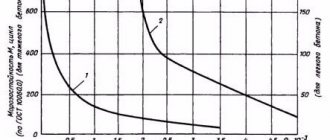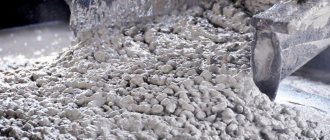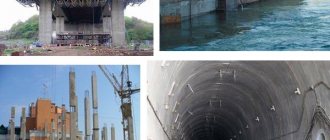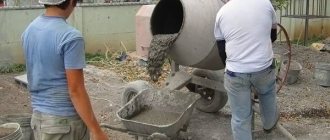An indispensable building material, heavy concrete is in demand in all areas of construction. Concrete M150 is the most common brand of building material, covering almost all the needs of private developers in concrete for construction: foundations, walls, partitions and other building structures.
Accordingly, heavy concrete M150 is the best option for the construction of a private or country house, including the construction of outbuildings: garages, bathhouses, sheds and premises for keeping pets.
Main technical characteristics
In accordance with current regulatory documents, concrete m150 class B10-B12.5 has the following consumer characteristics:
- Compressive strength of M150 concrete: 130-160 kg/cm2.
- Frost resistance: 75-150 freeze-thaw cycles.
- Water permeability: W2-4.
- Concrete weight m150 (1 m3): 2275 kg.
- Bending strength: 10 kg/cm2.
- Mobility: P1–P4.
- Density of concrete m150: 2275 kg/m3.
- Setting speed: fast setting.
Areas of use
If you need to create a small foundation under low loads, then using M150 concrete for this purpose is the best option. With proper reinforcement and compliance with the specified proportions of the components of the concrete mixture, the result will be a completely worthy structure. Such a foundation is unlikely to be suitable for a house, but it would be quite suitable for a garage or outbuilding.
In addition, class B12.5 concrete is used:
- when laying road surfaces;
- in the performance of work on the improvement of household territories and summer cottages;
- as an underlying layer for powerful foundations;
- for the manufacture of concrete blocks, curb stones, curbs, low-power lintels and other products not intended for heavy loads.
But when using this material when arranging a zero cycle, it is necessary to take into account the properties of the soil in a particular area, as well as the level of groundwater rise.
Composition of concrete M150
The composition of this type of building material is traditional for heavy concrete: cement, sand, crushed stone and water. At the same time, various additives and additives are used to impart special properties to concrete.
Traditionally, the following material is used: Portland cement CEM I 32.5N PC (M400) or CEM I 42.5N PC (M400) as the most affordable, quarry sand and crushed granite stone of 20-40 mm fraction.
As an option, river sand and crushed gravel can be used, and in non-critical cases, construction waste can be used instead of crushed stone: broken bricks, pieces of plaster, broken tiles, etc.
Concrete classes B 12.5 and B 15
Share:
20 Jan
| see prices for concrete order concrete Call!; |
Concrete class B 12.5 is widely used in many construction works, and corresponds to concrete grade M 150. Concrete of this class can be heavy and thin. Fillers for the heavy variety of concrete M 150 are high-density materials on granite, and for lean types crushed lime and gravel are used, as well as a low proportion of cement. Concrete class B 12.5 varies in terms of rigidity and mobility from Z1-Z4, from P1-P4.
By implying a concrete class with an index of 12.5, it is meant that this concrete is capable of withstanding a maximum load of up to 12.5 mPa per 1 m3 after hardening. This strength class allows the use of concrete of this brand in the following works: pouring foundations for fences and other various fences, building foundations for various types of outbuildings (terraces, bathhouses, sheds, utility blocks, etc.), pouring automobile and parking areas, concreting pedestrian and garden paths, carrying out internal construction work (floor screed). The main technical indicators of M 150 concrete are: frost resistance class F50 - F150 and water resistance class W2 - W4, which are determined and controlled by GOST 7473.
Order concrete now
from 2850 rub./m³
Price list for concrete >> Place an order for concrete >>
Concrete class B 15 corresponds to grade M 200 and has been one of the sales leaders for many years in the field of building materials. The composition of concrete of this class includes, in addition to standard ingredients (water, sand, cement), three types of crushed stone (lime, granite and gravel) with a grain size from 6 to 70 mm, which determines its high strength. According to standards, the aggregate must be twice the strength of the concrete grade. Concrete class B 15 implies the following technical properties of this brand of concrete: cone slump 10-15, water resistance W6, frost resistance F100. When producing M 200 concrete, the following proportions must be strictly adhered to. When using M400 cement - 10 l, the proportions of other ingredients are as follows: sand - 25 l, crushed stone 40 l. The final mass of the concrete solution is 54 liters. When using cement M500 - 10 l, other ingredients are taken in the following proportions: sand - 32 l, crushed stone - 49 l. The final mass of the concrete solution is 62 liters. The main areas of application of M 200 concrete concern places with particularly concentrated building loads (foundations, floor slabs, pouring platforms, stairs), as well as in the manufacture of monolithic structures with low load and reinforced concrete belts. The determination of the strength class of concrete is determined by its digital indicator. The higher the number, the stronger the concrete class. This figure also indicates the quality of the aggregate of a particular brand of concrete. Various construction works require concrete of different levels and strength classes. High-strength concrete used in special construction associated with the operation of buildings in extreme conditions starts with a value of B 25 and higher. Concrete with lower performance is actively used in private and industrial construction and solves a huge number of construction problems. The advantage of the most common classes of concrete, such as B 12.5 and B 15, is their low cost, a huge list of applications and the ability to obtain materials with predetermined technical properties and characteristics. , which is a manufacturer of the entire product line of concrete solutions, will produce high-quality material according to your order, and promptly deliver it directly to the client’s construction site.
Proportions for self-cooking
There are two ways to obtain concrete of this grade at a construction site. Order ready-made material from the nearest concrete plant or prepare the product yourself using universal tools and a concrete mixer.
For large volumes of pouring, it is more advisable to order delivery of concrete. For local work, it is advantageous to produce the material yourself by mixing the components in accordance with the following tables.
Table of proportions for concrete M150 per 1m3
| Cement brand | Proportions, kg C:P:SH:V | Cement, kg | Sand, kg | Crushed stone, kg | Water, l |
| TsEM I 32.5N PC | 1:3,4:5,3:0,9 | 215 | 735 | 1140 | 190 |
| TsEM I 42.5N PC | 1:4:6::6:1 | 190 | 755 | 1140 |
Table of proportions for concrete M150 in buckets per 1 m3
| Cement brand | Cement, number of buckets (10 l bucket) | Sand, number of buckets (10 l bucket) | Crushed stone, number of buckets (10 l bucket) | Water, number of buckets (10 l bucket) |
| TsEM I 32.5N PC | 16,5 | 52,5 | 81,5 | 19 |
| TsEM I 42.5N PC | 14,6 | 54 | 81,5 |
To make your own concrete, you can use a mechanical concrete mixer or a large sheet of iron placed on bricks.
How to prepare a concrete mixture
The consumption of basic materials for producing concrete of class B12.5 is determined depending on the desired quality of the final product and its main parameters. The magnitude of deviations from the basic proportions is influenced by the use of special additives and additives. But the traditional recipe almost always remains constant. So, to prepare 1 m3 of concrete mixture you need to take:
- 230-260 kg of Portland cement M400;
- 750-80 kg of sand;
- 1100-1200 kg of crushed stone or gravel;
- approximately 170 liters of water will be required, but its exact amount depends on the required hardness or plasticity of the resulting mixture.
When using a plasticizer, its consumption ranges from 2.5 kg to 4.5 kg in the form of an aqueous solution. Moreover, this amount reduces the costs of pure products. Cement consumption is adjusted by appropriate calculations.
It is most convenient to prepare a concrete mixture in a mobile concrete mixer, but you can also use simple means: a trough, a construction mixer or a hammer drill with an attachment in the form of a mixer, or, in extreme cases, a bayonet shovel.
The mixer drum must be slightly moistened with water and the dry ingredients must be loaded into it. Turn on the concrete mixer and mix everything for about two minutes. Then you should add the solution with additives with constant stirring, and continue to add water in small portions, achieving the desired consistency of the mixture. The mixing time should not be long, 5-7 minutes in total is enough.
Compliance with the technology for preparing B12.5 concrete and the calculated proportions of the starting materials is a guarantee of obtaining high-quality material at the optimal cost.
Average price per cube of concrete M150
For a private developer, there may be two prices for 1 m3 of concrete: the price of purchasing ready-made material at a concrete plant and the cost of independently preparing concrete directly at the construction site.
The purchase price of finished material based on granite crushed stone is on average 3,500 rubles per 1 m3, excluding delivery costs. The delivery price for 1 m3 depends on the distance and company of the seller.
For example, delivery of concrete over 5 km in the Moscow region and the Moscow region is 310 rubles/m3 or 1,860 rubles per 1 mixer run. Delivery over 30 km – 545 rubles/m3 or 3,270 rubles per 1 trip of a concrete truck.
The cost of preparing concrete yourself consists of the purchase price and delivery of components. Using tabular data on the consumption of components for cement grade TsEM I 32.5N PC, we will consider the cost structure and calculate how much 1 m3 of concrete will cost if prepared independently:
- Cement. The average retail price of 1 fifty-kilogram bag of cement of the specified brand is 260 rubles. Accordingly, 215/50X230 = 990 rubles.
- Sand. The average retail price of 1 ton of sand is 390 rubles. or 0.39 rub./kg. Accordingly: 735x0.39=286 rubles.
- Crushed stone. The average retail price of 1 ton of granite crushed stone is 1890 rubles. or 18.9 rubles/kg. Accordingly: 1140x1.89=2,154.6 rubles.
Let's sum up the costs for the purchase of basic materials: 990 + 286 + 2150.6 = 3,426 rubles. Not counting the cost of water and physical costs, 1 m3 of self-prepared M150 concrete will cost the developer approximately 3,426 rubles.
Advantages and disadvantages of concrete grade M150 (class B10-12.5)
Like any product, this material has a number of advantages and disadvantages. Before choosing, you should study them carefully. This is the only way you can finally decide whether this concrete is suitable for you or not.
The advantages of the M150 brand (B10-12.5) include:
- Easy to mix You can make the solution yourself if you have a concrete mixer.
- Low cost with average strength. According to its characteristics, the material surpasses the M100 grade and approaches M200. The price of the material is significantly lower than that of M200, at the level of M100.
- Easy to lay Concrete is quite flexible and lightweight, even beginners can work with it.
The disadvantages of the material include:
- Relatively low strength Concrete M150 (B10-12.5) cannot be used for all types of construction and road work.
- Low frost resistance Brand M150 (B10-12.5) can withstand about 50 cycles of freezing and thawing. This means that its guaranteed service life in cold climates is about 15-20 years. Therefore, it is better to use concrete for internal elements of the house structure and decoration.
- Average water resistance It is not advisable to use the brand in places with high humidity.
You have become familiar with all the possibilities for using concrete M150 (B10-B12.5), learned about its advantages and disadvantages. Now it will be easier for you to decide if this brand is right for your needs. You can mix it yourself or buy it at the factory. The price of the material on the market is below average.
Features, uses and price of concrete
The strength of concrete M-150 B12.5 allows it to be used for the manufacture of load-bearing elements in low-rise construction. Some additives can significantly improve the characteristics, which allows the use of this brand of material in areas with moderate seismic activity, humidity changes and significant wind loads. In most cases, a solution is needed:
- in road construction;
- in low-rise construction;
- in landscaping works.
During application, it is important to take into account geological features, since this material interacts with mineral rocks in different ways: to make a base for the foundation, soil with a high lime content must be thoroughly compacted.
Quality assurance
Our own construction laboratory carries out quality control at all stages of production of M-100 concrete. Laboratory specialists conduct daily monitoring of the quality of raw materials, finished products at the plant and directly at the construction site. The best proof of compliance of the finished product with GOST requirements will be the conclusion of a construction laboratory. It is important to consider that the mixture can be delivered to the construction site using a concrete pump. Yasaka LLC provides a wide range of concrete pumps with concrete delivery heights from 24 to 41 meters.
Detailed information by phone
Yalta +7 (978) 843-82-22 Sevastopol +7 (978) 727-18-03 Inkerman Opolznevoe
What is she pointing to?
This indicator is used to determine the weight per unit volume of the finished solution. This characteristic affects not only the strength of the finished building, but also:
- ease of working with concrete mixture: pouring, setting;
- degree of homogeneity of the finished solution.
The higher the indicator, the greater the wear resistance of the concrete structure. In addition, density affects the level of resistance to loads and overloads. Therefore, the densest mortars are used for the construction of high-strength structures and complex objects. And solutions with a lower level are for simpler or initially short-lived structures. For example, floor slabs or walkways.
What determines the density of concrete?
The concrete mixture consists of water, sand, cement, and various fillers. The density depends on the characteristics of each of these components. Namely from:
- mixing proportions;
- grades of cement;
- sand fineness module;
- size and type of crushed stone;
- composition of water, its quantity;
- method and conditions of hardening;
- use of plasticizers.
Each of these factors is necessarily taken into account during the manufacturing process of the material so that the finished mixture has the required parameters. At the same time, they do not forget about the shrinkage coefficient: indicators indicating how the dimensions of concrete decrease at different stages of its use.
Distinctive features and application of M150 concrete
Concrete grade M150 (strength class B12.5 according to GOST 7473-2010) is an environmentally friendly building material with a high setting speed that requires additional waterproofing. Due to its availability and durability, the material is actively used:
- when constructing foundations for light private buildings (gazebos, garages, sheds, etc.);
- as a “cushion” under heavily trafficked roads;
- for interior decoration (leveling walls, floors);
- when pouring the base for posts for garden paths, fences, borders;
- as a supporting base for the foundation after compacting the soil.
The composition of the mixture includes a small amount of binder, insufficient to achieve serious resistance to frost and moisture. Because of this, the material is not used in critical structures that must withstand the harsh influence of the external environment.











